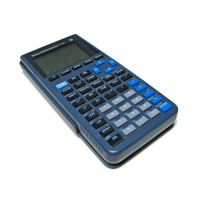Appendix B: Technical Reference 897
Specifies the units in which angle values are interpreted and displayed in
trig functions and polar/rectangular conversions.
1:RADIAN
2:DEGREE
Specifies which notation format should be used. These formats affect only
how an answer is displayed; you can enter a number in any format.
Numeric answers can be displayed with up to 12 digits and a 3-digit
exponent.
1:NORMAL Expresses numbers in standard format. For example,
12345.67
2:SCIENTIFIC Expresses numbers in two parts:
¦ The significant digits display with one digit to the
left of the decimal.
¦ The power of 10 displays to the right of E.
For example, 1.234567E4 means 1.234567×10
4
3:ENGINEERING Similar to scientific notation. However:
¦ The number may have one, two, or three digits
before the decimal.
¦ The power-of-10 exponent is a multiple of three.
For example, 12.34567E3 means 12.34567×10
3
Note: If you select NORMAL, but the answer cannot be displayed in the
number of digits selected by Display Digits, the TI-89
Titanium / Voyage™ 200 displays the answer in SCIENTIFIC notation. If
Display Digits = FLOAT, scientific notation will be used for exponents of 12
or more and exponents of ì4 or less.
Specifies whether complex results are displayed and, if so, their format.
1:REAL Does not display complex results. (If a result is a
complex number and the input does not contain the
complex unit
i
, an error message is displayed.)
2:RECTANGULAR Displays complex numbers in the form: a+bi
3:POLAR Displays complex numbers in the form: r
e
i
q
Angle
Exponential Format
Complex Format

